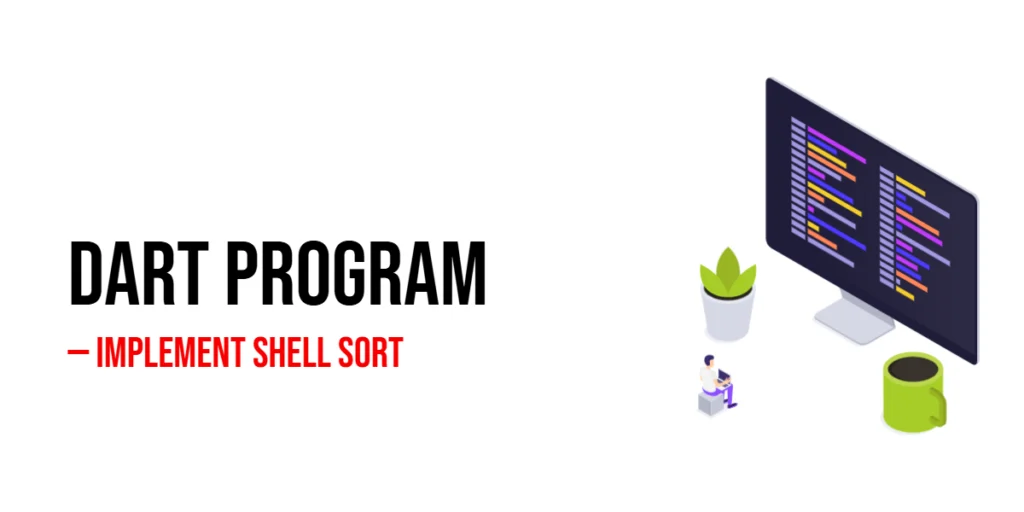Sorting is a fundamental concept in programming that helps organize data efficiently. Shell Sort is an improvement over simple sorting techniques like Insertion Sort. It allows elements far apart from each other to move toward their correct positions faster, reducing the total number of comparisons and shifts. This makes it particularly useful for medium-sized datasets where efficiency matters but you want to avoid overly complex algorithms.

with hands-on learning.
get the skills and confidence to land your next move.
For beginners, learning Shell Sort in Dart is an excellent way to understand how incremental improvements in sorting algorithms can significantly improve performance. Shell Sort is widely used in applications such as arranging data in databases, organizing arrays for faster searches, and in scenarios where memory efficiency is important. Implementing it also helps you understand concepts like gap sequences, loops, and incremental sorting logic, all of which are crucial for mastering algorithmic thinking.
Program 1: Basic Shell Sort
This program demonstrates the classic Shell Sort approach using a simple gap sequence. It sorts an array by repeatedly comparing elements that are a certain gap apart and gradually reducing the gap until the array is fully sorted.
void shellSort(List<int> arr) {
int n = arr.length;
for (int gap = n ~/ 2; gap > 0; gap ~/= 2) {
for (int i = gap; i < n; i++) {
int temp = arr[i];
int j;
for (j = i; j >= gap && arr[j - gap] > temp; j -= gap) {
arr[j] = arr[j - gap];
}
arr[j] = temp;
}
}
}
void main() {
List<int> numbers = [23, 12, 1, 8, 34, 54, 2, 3];
print("Original Array: $numbers");
shellSort(numbers);
print("Sorted Array: $numbers");
}In this program, elements are moved in increments defined by the gap. As the gap reduces, elements gradually settle into their correct positions. Beginners can see how breaking the sorting into stages speeds up the process compared to simple insertion sorting.
Program 2: Shell Sort with Different Gap Sequence
Here, we implement Shell Sort using a custom gap sequence to explore how different sequences can influence performance. It demonstrates that choosing the right gaps can make sorting faster for certain arrays.
void shellSortCustomGaps(List<int> arr) {
int n = arr.length;
List<int> gaps = [5, 3, 1]; // Custom gap sequence
for (int gap in gaps) {
for (int i = gap; i < n; i++) {
int temp = arr[i];
int j;
for (j = i; j >= gap && arr[j - gap] > temp; j -= gap) {
arr[j] = arr[j - gap];
}
arr[j] = temp;
}
}
}
void main() {
List<int> numbers = [45, 23, 53, 12, 3, 8, 1];
print("Original Array: $numbers");
shellSortCustomGaps(numbers);
print("Sorted Array: $numbers");
}By using a different gap sequence, this program highlights how flexibility in algorithm design can optimize performance. Beginners learn the idea of experimentation and tuning for efficiency.
Program 3: Shell Sort with Floating-Point Numbers
Shell Sort can also handle floating-point numbers efficiently. This program demonstrates sorting decimal numbers in Dart.
void shellSortDoubles(List<double> arr) {
int n = arr.length;
for (int gap = n ~/ 2; gap > 0; gap ~/= 2) {
for (int i = gap; i < n; i++) {
double temp = arr[i];
int j;
for (j = i; j >= gap && arr[j - gap] > temp; j -= gap) {
arr[j] = arr[j - gap];
}
arr[j] = temp;
}
}
}
void main() {
List<double> numbers = [23.5, 12.1, 1.0, 8.6, 34.3, 2.2];
print("Original Array: $numbers");
shellSortDoubles(numbers);
print("Sorted Array: $numbers");
}Sorting decimal numbers helps beginners understand that Shell Sort is versatile and works for both integers and floating-point values without any structural changes.
Program 4: Shell Sort Using Recursion
Although Shell Sort is usually implemented iteratively, it can also be expressed recursively. This program sorts the array by repeatedly reducing the gap recursively.
void recursiveShellSort(List<int> arr, int gap) {
int n = arr.length;
if (gap == 0) return;
for (int i = gap; i < n; i++) {
int temp = arr[i];
int j;
for (j = i; j >= gap && arr[j - gap] > temp; j -= gap) {
arr[j] = arr[j - gap];
}
arr[j] = temp;
}
recursiveShellSort(arr, gap ~/ 2);
}
void main() {
List<int> numbers = [29, 10, 14, 37, 13, 5];
print("Original Array: $numbers");
recursiveShellSort(numbers, numbers.length ~/ 2);
print("Sorted Array: $numbers");
}Recursion shows beginners how repeated logic can be applied in smaller subproblems. It also reinforces the concept of breaking a problem down into stages, which is central to many algorithms.
Program 5: Shell Sort for Reverse Ordered Array
This program demonstrates Shell Sort’s efficiency when handling arrays sorted in descending order. It emphasizes the advantage of Shell Sort over simple insertion sort for nearly sorted or reverse-ordered data.
void shellSortReverse(List<int> arr) {
int n = arr.length;
for (int gap = n ~/ 2; gap > 0; gap ~/= 2) {
for (int i = gap; i < n; i++) {
int temp = arr[i];
int j;
for (j = i; j >= gap && arr[j - gap] < temp; j -= gap) {
arr[j] = arr[j - gap];
}
arr[j] = temp;
}
}
}
void main() {
List<int> numbers = [50, 40, 30, 20, 10];
print("Original Array: $numbers");
shellSortReverse(numbers);
print("Sorted Array (Descending): $numbers");
}This version helps beginners understand how Shell Sort can be adapted for different sorting orders by adjusting the comparison logic.
Frequently Asked Questions (FAQ)
Here are some common questions beginners may have about Shell Sort:
Q1: What is the time complexity of Shell Sort?
The average-case time complexity is between O(n log² n) and O(n²), depending on the gap sequence used.
Q2: When should I use Shell Sort?
Shell Sort is suitable for medium-sized datasets where simple algorithms like Insertion Sort are too slow but advanced algorithms like Quick Sort may be overkill.
Q3: Is Shell Sort stable?
No, Shell Sort is generally not stable because it may move equal elements past each other during gap-based comparisons.
Q4: Can Shell Sort work with floating-point numbers?
Yes, Shell Sort works with integers, floating-point numbers, or any type that supports comparisons.
Q5: How does Shell Sort compare to Insertion Sort?
Shell Sort is a generalization of Insertion Sort. It reduces the total number of comparisons by allowing elements to move multiple positions in a single step.
Conclusion
Shell Sort is an effective and versatile sorting algorithm that bridges the gap between simple and advanced sorting techniques. In this article, we explored multiple implementations in Dart, including basic sorting, custom gap sequences, sorting floats, recursion, and reverse-ordered arrays.
For beginners, practicing Shell Sort enhances understanding of loops, comparisons, recursion, and incremental problem-solving. Experimenting with different gap sequences and data types builds algorithmic intuition and prepares you to handle more complex sorting challenges with confidence.







